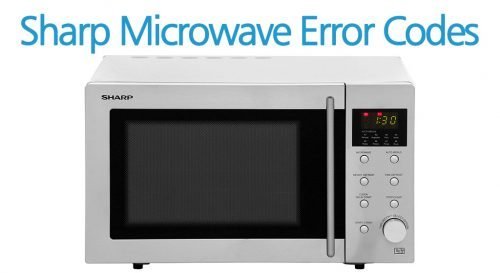
Microwaves, like any other household appliance, can experience hiccups. They’re sophisticated electronics built with intricate circuits and parts that occasionally falter. Error Code F1 is often an indication that there’s a fault with the touchpad or control board of your Sharp microwave. Just like how our smartphones sometimes freeze and need a reset, microwaves might need a similar intervention. But the catch is, how do you know when it’s a minor glitch you can fix or a more serious issue that warrants a technician’s expertise?
Understanding Error Code F1 in Sharp Microwaves
To demystify this error, let’s delve a little deeper into what Error Code F1 actually signifies. Usually, this error relates to a malfunction in the touchpad or the central control board. Imagine this like your car’s dashboard lighting up with a warning signal. It lets you know there’s an underlying issue needing investigation. The touchpad, where you press buttons to set cooking time and power levels, can sometimes fail due to wear and tear or a simple electrical surge.
A common scenario is when the connections within the touchpad become faulty. This could be due to frequent use, which over time, wears down connections just like how constant use of a computer keyboard can make some keys unresponsive. Moreover, environmental factors like humidity or dust can creep into your microwave’s delicate parts, causing performance issues.
If you notice that the error appears intermittently or after certain operations, it could be a sign that the fault is developing rather than being persistent. While it might be tempting to ignore these signals hoping they’ll disappear, it’s essential to address them promptly. Ignoring them might lead to more severe issues or even complete failure of the appliance. So, what’s a microwave owner to do?
Steps to Troubleshoot Before Calling a Technician
Before you rush to your phone to call a technician, there are a few troubleshooting steps you can try at home. First, try the classic fix: unplug the microwave. Leave it unplugged for about 10 to 15 minutes, then plug it back in. This simple reset can sometimes clear temporary electronic hiccups, much like restarting your computer to resolve software glitches.
Next, check the microwave door. Ensure it closes properly because many models won’t operate if the door isn’t secured. A misaligned door could trigger error messages due to safety switches not engaging as they should. Also, examine the touchpad for any physical damages or signs of wear and tear. If some buttons are not responding, there might be a specific issue with the control panel.
Still seeing the error? It’s wise to consider the environment. Is your kitchen especially humid or is the microwave located near a heat source like the stove? Excessive moisture or heat can affect the performance of electronic components. If these self-checks don’t resolve the issue, it might be time to seek expert help. After all, microwaves are high-voltage appliances, and delving deeper without proper knowledge can be dangerous.
When It’s Time to Call a Technician
So, when do you throw in the towel and call a professional? If you’ve tried the above steps and the Error Code F1 stubbornly persists, it’s a clear sign that deeper technical expertise is needed. A technician is like a doctor for your appliance, with tools and knowledge to diagnose and treat the problem accurately.
Persistent errors often point to deeper issues such as a faulty control board, which isn’t something you’d typically fix at home without specialized equipment. Furthermore, if you notice other irregularities like unusual noises, burning smells, or the microwave failing to heat food properly, it’s best to avoid risk and contact a technician. Attempting a DIY fix in these scenarios might exacerbate the problem or create safety hazards.
Before you make the call, gather all the details about your microwave model and the error occurrences. Providing this information to the technician can help them assess the situation more effectively and prepare necessary parts, potentially saving time and repair costs.
Taking Care of Your Microwave for Longevity
Prevention is always better than cure, isn’t it? Regular maintenance can keep your microwave running smoothly and prevent future errors. Ensure you clean the interior regularly to avoid food debris that might affect operation. Use a damp cloth for the exterior, focusing on the touchpad area, ensuring no food particles or moisture remains.
Position your microwave away from direct heat sources and ensure it’s installed in a cool, dry place to prevent overheating and moisture buildup. It’s comparable to storing your books in a dry area to prevent damage from humidity. Additionally, using the microwave according to the manufacturer’s instructions can significantly reduce the risk of error codes popping up.
Lastly, consider annual check-ups by a technician to nip potential problems in the bud. It’s like taking your car for a service – it might seem like an upfront cost but could save you from future headaches and wallet woes.
By understanding what your Sharp microwave’s Error Code F1 means and taking appropriate action, you can ensure its longevity and reliability. Whether it’s a quick DIY fix or calling in the pros, you’re now equipped to tackle the problem with confidence and ease.